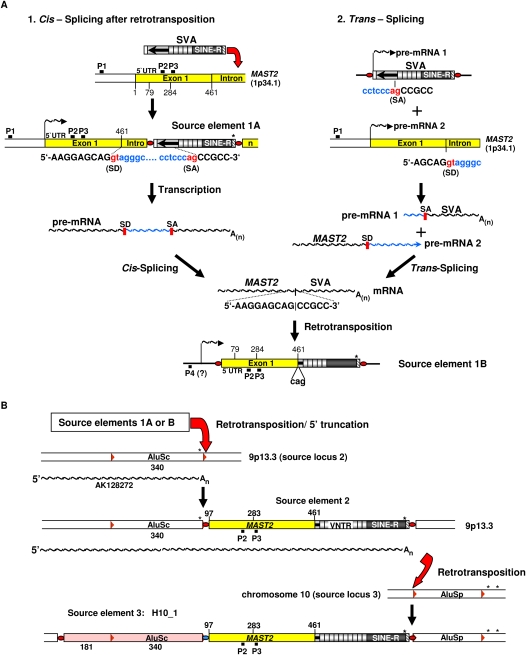Figure 8.
Evolutionary scenarios for the emergence of SVA subfamily F1. (A) Schematic diagram of two alternative scenarios giving rise to hypothetical precursor source elements 1A or B of the SVA_F1 subfamily, respectively. Alternative 1: Cis-splicing after retrotransposition; after SVA retrotransposition into the MAST2 gene downstream of exon 1, transcription of source element 1A is controlled by the MAST2 promoter P1 or by potential regulatory sequences in exon 1 (P2, P3) resulting in a chimeric MAST2-SVA pre-mRNA. Cis-splicing of the pre-mRNA removes the intronic sequence flanked by the splice donor (SD) site at the MAST2 exon 1–intron junction and the cryptic splice acceptor (SA) site localized within the Alu-like region. Retrotransposition of the spliced, chimeric MAST2-SVA transcript results in the 5′-transducing source element 1B. Transcription of this element could have been controlled by internal promoter sequences located within the MAST2 sequence (P2, P3) or by an external promoter localized upstream of the SVA_F1 insertion (P4). Nucleotide position 79 indicates the 5′-end of the MAST2 sequence of SVA H15_5 (Fig. 7A) that harbors the most extensive MAST2 5′-transduction. Position 284 denotes the 5′-end of the putative cryptic promoter sequence P3; asterisks indicate transcription termination signals. Alternative 2: Trans-splicing; two separate pre-mRNA molecules encoding an SVA element (pre-mRNA 1) and the MAST2 protein (pre-mRNA 2), respectively, are synthesized. Pre-mRNA 2 provides the 5′ splice site (splice donor [SD]), pre-mRNA 1 harbors branchpoint sequence, poly-pyrimidine tract, and a cryptic 3′ splice site (splice acceptor [SA]). The exons of the two separate pre-mRNA molecules are joined by trans-splicing to create a single chimeric RNA. Retrotransposition of this RNA would result in source element 1B. The 5′-transduced MAST2 sequence of source element 1B could either be full-length or 5′-truncated. In theory, members of transduction group 1 (Fig. 7A) could be direct descendants of source elements 1A or B. Splice donor and splice acceptor sequences are highlighted in red. P1, MAST2 promoter; P4, hypothetical external promoter controlling transcription of source element 1B. (B) Evolutionary scenario giving rise to source element H10_1. Retrotransposition of source element 1A or B into the 3′ TSD of an AluSc element on chromosome 9p13.3 is setting the newly integrated 5′-truncated MAST2-SVA element (source element 2) under control of the AK128272 promoter. Transcriptional read-through causes a chimeric AK128272-MAST2-SVA transcript. 5′ Truncation in the process of retrotransposition of the chimeric RNA into the 5′ TSD of an AluSp element in source locus 3 results in the 5′-transducing source element H10_1. The SVA-free source locus 3 is still present on chromosome 10 of both rhesus macaque and chimpanzee genomes but absent from humans. H10_1 served as source element for all members of SVA_F1 transduction group 4.

